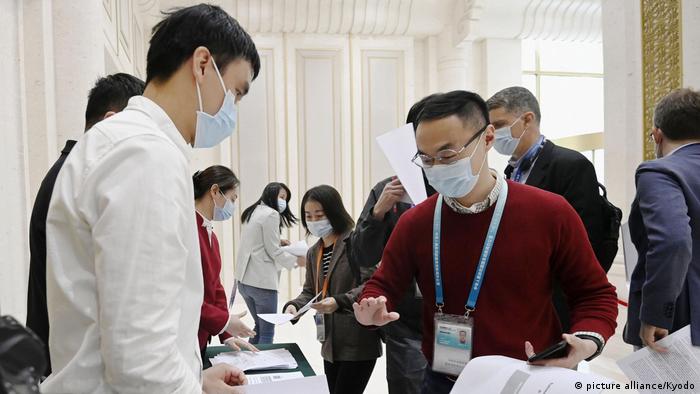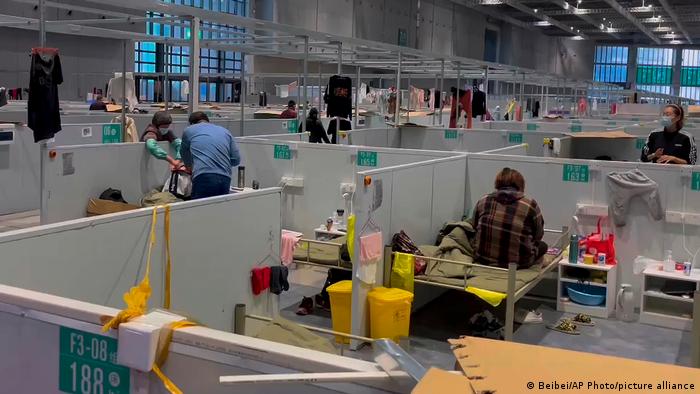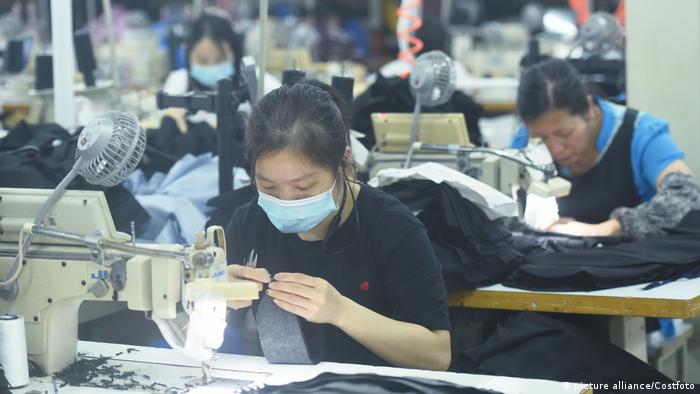China: First quarter economic growth slightly tops forecast
Beijing reported a 4.8% growth for the first quarter, a modest increase over the previous quarter’s 4%. The country’s economy has been stalling amid coronavirus outbreaks.
 Journalists on Monday received an economic report from China’s National Bureau showing 4.8% economic growth for the first quarter of the year
Journalists on Monday received an economic report from China’s National Bureau showing 4.8% economic growth for the first quarter of the year
China’s economic growth rose modestly to 4.8% for the first quarter of 2022 as the country suffers an economic slowdown amid coronavirus outbreaks and a major real-estate crisis.
The previous quarter’s growth was 4%. Analysts had predicted 4.4% growth for the first quarter of 2022.
This quarter’s growth has fallen well below the official target of 5.5% for 2022.
“The national economic recovery was sustained and the operation of the economy was generally stable,” China’s government said in a statement.
China’s real-estate crisis
The rise followed a slump triggered by tighter government controls on China’s real estate industry. The controls hit the country’s construction industry, which supports millions of jobs.
Investors have been nervous about possible defaults by developers as a result of the new controls.
One of China’s largest developers, Evergrande Group, has struggled to avoid default since last year. The company owns $310 billion (€287) in liabilities to banks and bondholders.
Smaller developers have collapsed or defaulted on debts after the Chinese government put limits on the amount of money they could borrow.
 Commercial center Shanghai has been grappling with a coronavirus outbreak that threatens to disrupt global supply chains
Commercial center Shanghai has been grappling with a coronavirus outbreak that threatens to disrupt global supply chains
COVID-19 lockdowns affecting international trade
China’s economy has also struggled to rebound amid lockdowns in major commercial center Shanghai and elsewhere due to coronavirus outbreaks. China has implemented a strict “zero-COVID” policy since the beginning of the pandemic.
Researchers for the ING banking group say that April data is likely to show lower growth than the first three months of the year as these lockdowns drag on.
“Further impacts from lockdowns are imminent, not only because there has been a delay in the delivery of daily necessities, but also because they add uncertainty to services and factory operations that have already impacted the labour market,” ING economist Iris Pang said.
The suspension of access to Shanghai has disrupted the flow of industrial goods, and global manufacturers have reduced or stopped production.
Other cities affected include petrochemical center and port Tianjin, finance and tech center Shenyhen and manufacturing centers Changchun and Jilin. Smaller cities have also closed businesses or imposed coronavirus-related controls.
Tommy Wu of Oxford Economics said that this disruption will likely “weigh on activity in April and into May, if not longer.” He added that this is “likely to have a significant impact on global supply chains.”
China’s trading partners have been hit with lower demand for oil, steel, consumer goods and food in light of the slowdown. Oil prices have fallen in the light of lower expectations of Chinese consumption after having soared due to Russia’s invasion of Ukraine.
sdi/fb (AP, AFP, Reuters)































